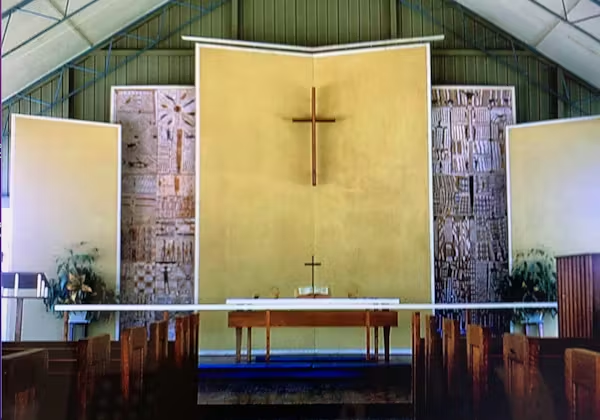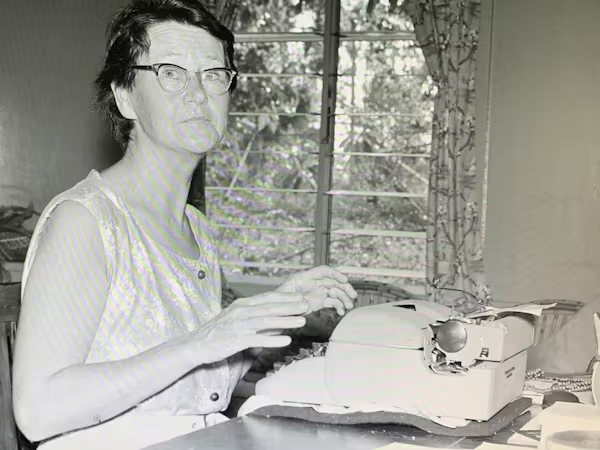It was a momentous double act of diplomacy….offering a form of treaty between two sovereign nations. “You are now initiated into our law, so please show respect to our sovereign nation”.
It all sounds so relevant to the debates of the past year or two over the Uluru Statement and the Voice referendum. But historian Clare Wright is in fact talking about events of 1963 in Yirrkala, east Arnhemland when the Yolŋu people came up with the Bark Petitions, decorated with their traditional artwork, to send to the Federal Parliament complaining that land they had always known of as theirs was being given to foreign miners without any consultation.
No Aboriginal group had ever made such a land rights claim before and certainly not used such a literate Westminster process to describe their distress.
This was 1963 – such a comparative split second ago in a 65,000 year history. But, just 60 years ago, it was a time when the first appearance of “full-blooded” Aboriginal dancers in Melbourne could be headlined, “Stone Age Stars”. When most of the NT was divided into Missionary provinces given responsibility for the native wards on Reserves where protection from “the pressures of modern competitive living” was the priority, even ahead of the government’s 1952 assimilation project. When 12,000 years was the accepted limit for the Indigenous occupation of this continent. When the miner Ben Dickinson could describe Yolŋu Country as “one of the few remaining waste areas of the world” which (unfortunately) had tons of bauxite beneath its surface which he was determined that French company Pechiney should dig up. For, as Geoffrey Blainey had commemorated in those pre-lapsarian times, Australia’s passion of development was ‘The Rush that Never Ended’. And when the Daily Telegraph was still a serious newspaper!
But it was also a time when 150,000 people demonstrated for desegregation in the US – though Martin Luther King (and John F Kennedy) would be assassinated in consequence. Even in Australia, the Electoral Act of 1962 had given Aborigines the vote in Federal elections. And in distant Melbourne, there existed a Federal Council for the Advancement of Aborigines. In Canberra, ALP trouble-makers like Kim Beazley Snr and Gordon Bryant were delivering (non-Indigenous) petitions to change the Constitution, which were eventually accepted by forever PM, Bob Menzies.
But much closer in Darwin, Director of Welfare (for the natives) Harry Giese, who’d given ‘his’ wards surnames against their will in order to standardise his records, was confident he knew the Yolŋu were “a relatively unsophisticated group, swayed in their views by the last person in authority”, such as himself.
Or Superintendent Edgar Wells, the 15 year veteran of Arnhemland mission life, now head of the Methodist mission at Yirrkala. For it was Wells that Giese, Paul Hasluck his responsible Minister in Canberra, and Wells’s boss in Sydney, Cecil Gribble were all convinced was the rabble-rouser who’d incited the Yolŋu to action.
Little did they know (or understand) of the complexity of Yolŋu society and the subtle methods by which they came to diplomatic decisions. Fortunately, Clare Wright does. For instance, she uses no surnames for the many Yolŋu names that were players in this saga or were her informants during two lengthy periods embedded in Yirrkala. Heading the latter was the late Gumatj leader Galarrwuy, who was but a schoolboy when events kicked off, but who, as Mungurrawuy’s son, knew that he had to understand what was happening and be able to translate it in and out of English if he was to succeed his father. For this, as Wells tried to explain, was still a time when “secure tenure of their ancestral lands was a matter of life and death, and potential tribal disintegration” for the Yolŋu.
And it was Wells who first suggested a method by which the Yolŋu could communicate some of these matters. He’d insisted on building a new church, and he wanted something Yolŋu to be part of its symbolic decoration. The Church Panels (dumped by a subsequent superintendent) were the result, with detailed Yirritja and Dhuwa artworks to stand either side of a plain Christian cross. Yolŋu diplomacy chose both subject matter and the right painters – lead by elder artists Mawalan and Birrikitj – to achieve the panels, painted in secret in the old church, but annotated scrupulously by Ann Wells, Edgar’s wife, mission typist and keeper of the extensive Wells Archive that Wright has accessed.
It was her sources that revealed the intricate connection between animal and vegetable food sources and land rights across the Yolŋu tribes. And bringing them together for the Panels was an essential precursor to work on the Bark Petitions. Oddly, though, it was MP Kim Beazley, a religious man who’d been delighted by the Panels, who actually suggested that a typed petition to Parliament would have greater significance if surrounded by bark art. They certainly attracted headlines down South, even if Minister Hasluck managed only condescension. Infuriatingly, a problem lay in the Petitions’ signatures, which, of course, could only be penned by the younger beneficiaries of the mission school. To overcome this, the typed words were re-sent accompanied by the worn thumbprints of elders.
And it worked! A select committee was appointed to go to Yirrkala to test the Yolŋu, and, under pressure of an election, it swiftly produced a result which admitted there’d been no consultation, and that as citizens not wards, the Yolŋu had native title to their land. But the mine would proceed. And a community of 500 would soon be inundated by a town of 5000 miners, alcohol, domestic violence and wire fences despite a subsequent law case which decided they had only “a religious relationship” to their land.
Will it all end rather more happily than this? For the irrepressible Yolŋu went to court again just before Galarrwuy died in 2022, claiming $700m compensation for their land, lost without consent. The Federal Court agreed with him in 2023, but the Commonwealth has appealed the case to the High Court, which may or may not agree.
And the great news is that the High Court today (12/3) has agreed. It was Yolŋu land held by native title, and they lost it without consent! Compensation to come.
Well, those are the facts spread over 640 pages through Wright’s magnificent book. But her genius is to lard that story with so many insights into the traditional Yolŋu world view – many borrowed from the book Songspirals – and background commentary from non-Indigenous sources such as the Wells Archive and Marg Croxford’s insightful letters back home. Just a tiny example – the Christmas pageant of course required a Mary and a Joseph. But how to choose a Yolŋu woman who could appear pregnant in just the right relationship with her carpenter husband?? Another work of subtle diplomacy! Or Ann Wells’s summation that “the Yolŋu seized their chance to have their say on their own land rather than have an Australia built over the graves of their relatives and the torn shreds of their ancient dreams”.
No fewer than seven professors have blurbed their praise for Naku Dharuk – which is Yolŋu matha for bark messages. You’ll learn a lot more of the language in the book, such as “Yol nha dhal” – “who wants this?” And how to pronounce it. For that was the angry query uttered when white wooden pegs were discovered driven into the peanut plantation by uninvited mining surveyors. I’d add my enthusiastic non-professorial praise for a book that not only tells a vital tale of Australian democracy but offers so many insights into the world view that creates such great Yolŋu art. And you don’t have to suffer through Waltjanmirri, Midawarr, Dharratharramirri, Rarrandharr, Wolmamirri and Barramirri – the six Arnhemland seasons that will continue to roll reliably through even after Rio Tinto (now the owners) closes its bauxite mine in 2030 and, purportedly, remediates the despoiled Yolŋu land.
Naku Dharuk by Prof Clare Wright (now Chair of the National Museum Board) comes from Text Publishing at just $45.




